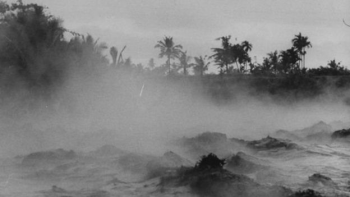The February 1963 to January 1964 eruption of Gunung Agung, Indonesia’s largest and most devastating eruption of the twentieth century, was a multi-phase explosive and effusive event that produced both basaltic andesite tephra and andesite lava. A rather unusual eruption sequence with an early lava flow followed by two explosive phases, and the presence of two related but distinctly different magma types, is best explained by successive magma injections and mixing in the conduit or high level magma chamber. The 7.5-km-long blocky-surfaced andesite lava flow of ∼0.1 km3 volume was emplaced in the first 26 days of activity beginning on 19 February. On 17 March 1963, a major moderate intensity (∼4 × 107 kg s−1) explosive phase occurred with an ∼3.5-h-long climax. This phase produced an eruption column estimated to have reached heights of 19 to 26 km above sea level and deposited a scoria lapilli to fine ash fall unit up to ∼0.2 km3 (dense rock equivalent—DRE) in volume, with Plinian dispersal characteristics, and small but devastating scoria-and-ash flow deposits. On 16 May, a second intense 4-h-long explosive phase (2.3 × 107 kg s−1) occurred that produced an ∼20-km-high eruption column and deposited up to ∼0.1 km3 (DRE) volume of similar ash fall and pyroclastic flow deposits, the latter of which were more widespread than in the March phase. The two magma types, porphyritic basaltic andesite and andesite, are found as distinct juvenile scoria populations. This indicates magma mixing prior to the onset of the 1963 eruption, and successive injections of the more mafic magma may have modulated the pulsatory style of the eruption sequence. Even though a total of only ∼0.4 km3 (DRE volume) of lava, scoria and ash fall, and scoria-and-ash pyroclastic flow deposits were produced by the 1963 eruption, there was considerable local damage caused mainly by a combination of pyroclastic flows and lahars that formed from the flow deposits in the saturated drainages around Agung. Minor explosive activity and lahar generation by rainfall persisted into early 1964. The climactic events of 17 March and 16 May 1963 managed to inject ash and sulfur-rich gases into the tropical stratosphere.







Enable comment auto-refresher